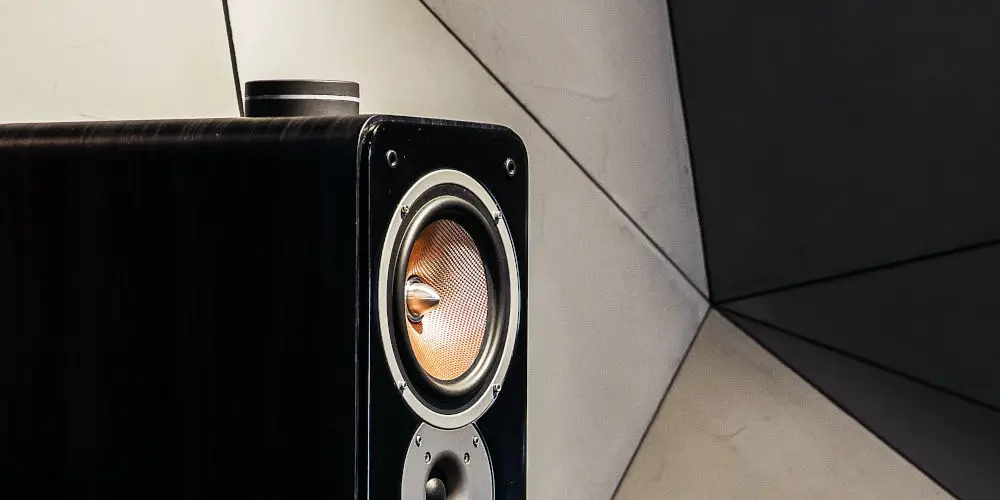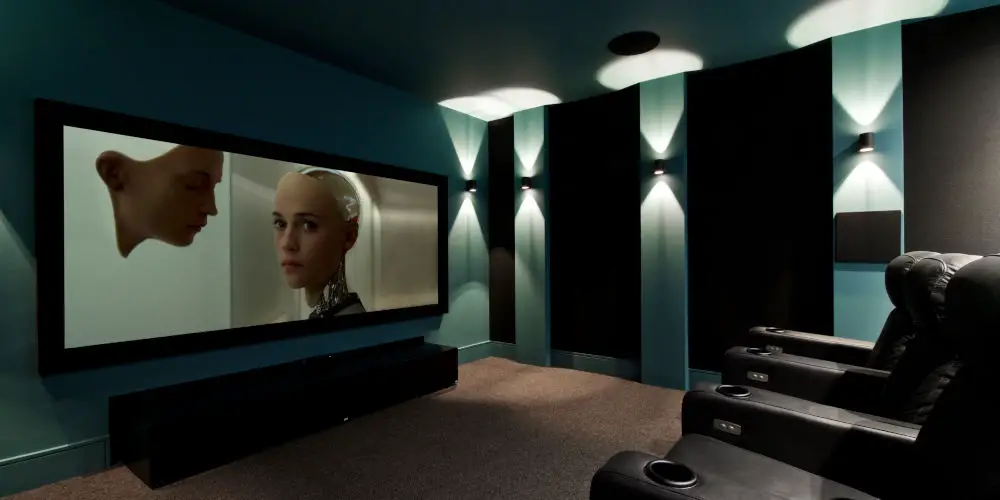Will Dolby Atmos work with any TV?

Dolby Atmos provides one of the ultimate home cinema sound currently available. It’s even better than the traditional surround sound. Plus, Atmos is available on phones, TV, AV receivers, soundbars and more. But will Dolby Atmos work with any TV?
The typical surround sound systems create an almost 3D experience but they lack overhead sounds, hence why Dolby invented Atmos. Even though the technology is barely a decade old, it has elevated the home cinema experience to new heights.
If you’re looking to upgrade your TV or AV receiver, you might see the Dolby Atmos stick on units; or it mentioned in the description. The good news is you don’t need a Dolby Atmos TV to enjoy Dolby Atmos surround sound.
The reason is simple, the Atmos technology is enabled by receivers or speaker systems. With the right hardware meaning, Dolby Atmos works on almost any TV.
Let’s explore will Dolby Atmos work with any TV and discover why your current TV is ideal.
What is Dolby Atmos?
Dating back to 2012, Dolby Atmos actually isn’t anything new. Instead, Dolby tweaked existing technology to make it more flexible. By 2020, over 6,000 commercial theatres have an Atmos system installed, and it’s even more popular with consumer electronics brands.
You can think of Dolby Atmos as a type of metadata or a string of information. Rather than mixing sound in channels, individual sounds are treated as objects, which can move freely in 3D space.
We used to mix audio using discrete channels. Think of stereo speakers. You might hear a door open on the left speaker and then someone is heard speaking on the right speaker. You can hear the different sounds, but they might not sit correctly to where the action happens.
Another example, is the centre speaker in a traditional 5.1 surround system handles the dialogue, regardless of where the action is taking place. You could have someone jumping from a helicopter overhead but you’ll still hear them speak from the front.
At home, you have a single centre channel, which doesn’t fully replicate the multiple centre speakers used by a commercial theatre. Sadly, you simply won’t get the sound separation from a single speaker.
Dolby Atmos changes how audio is mixed. It allows audio professionals to allocate sounds as objects in 3D space, meaning you hear sounds exactly where they appear.
In a commercial theatre or home cinema, this information is decoded seamlessly and is reproduced by a single or multiple speakers at that location. By using a 3D sound field, Atmos creates a more accurate surround sound that brings movies to life with a fully immersive experience.

What are you listening to with Dolby Atmos?
Dolby Atmos isn’t a sound format, it’s the metadata that holds information about the sound. Currently, Dolby Atmos is compatible with two sound signals from Dolby TrueHD and Digital Plus.
Dolby TrueHD
Dolby TrueHD is a lossless high bandwidth format that is an audiophiles’ dream! That said, it’s only currently available with UHD Blu-ray discs and regular Blu-ray discs.
Certain media players also support Atmos via TrueHD and allow you to stream movies from your computer to your TV either by an HDMI cable or wirelessly through the internet.
Dolby Digital Plus
The majority of us enjoy Dolby Atmos with Dolby Digital Plus. It’s a lossy format with a lower bandwidth, so is ideal for streaming services. A wide range of devices supports Digital Plus, including phones, laptops, streaming boxes like Roku, Apple TV, and Amazon Fire Cube.
Streaming services like Netflix and Amazon Prime Video also use Dolby Atmos over Dolby Digital Plus.
Do you need a specific TV to enjoy Dolby Atmos?
As a unique way to present sound, your current TV should be fine to use with Dolby Atmos. Most TVs suffer from poor sound due to tiny, rear-mounted speakers that are unable to reproduce the level of quality we desire for Atmos.
So it doesn’t make sense to upgrade your TV to one that offers Atmos. It’s likely, most newer Atmos-enabled TVs will only offer virtual Atmos using software and its two rear speakers. And while this will sound slightly better, you won’t be enjoying the full Atmos experience.
Leave the Atmos simulations to headphones or earbuds as they sound quite convincing but don’t replicate the experience possible in a home cinema room or lounge with the right equipment.
Rather than upgrading your TV, invest in an AV receiver, speakers, and even soundbars with upward-firing drivers.
The only exception when you might need an Atmos-enabled TV is if you’re using a streaming app on your smart TV that requires native decoding. Of course, there is a high cost of buying such a TV, for example, LG OLED55CX5LB or a Samsung TV. But you might need to bite the bullet.

How to ensure Atmos compatibility
Even though you don’t need an Atmos-enabled TV, you do need a few compatible components. The most critical element is the film or content mixed for an Atmos system. Next, you need a compatible AV receiver and the right number of speakers. Let’s look at each of these parts.
Content
Whatever you plan to watch needs to be encoded with Dolby Atmos. You can stream, download or buy physical discs of content that are encoded for Atmos sound.
If you’re streaming, check if the service provides content in Atmos. Popular services such as Amazon Prime Video, Amazon Prime Music, Tidal, Netflix, and Apple Music, all deliver content with Dolby Atmos playback.
Hardware
If you’re using a streaming device such as a Chromecast or Fire TV stick, check that it can handle Atmos. Many first-generation devices don’t, so be careful. Thankfully, updating your streaming stick is highly affordable.
At worst, you should invest in a soundbar with built-in upfiring Atmos drivers. A better option is to use a compatible AV receiver with either 5.1 or 7.1 surround speakers and 2 or 4 Atmos drivers.
Whichever option you use, you should connect with your TV or AV receiver or soundbar via HDMI ARC.
Speakers
As we’re trying to avoid using virtual Atmos, we need to use additional speakers on top of our surrounding sound speaker set up. Two options are available, either ceiling speakers or upfiring drivers.
You can add Atmos speakers to your ceiling. However, this is time-consuming and expensive as you need to drill holes for the speakers and cables. The other option is to use upfiring drivers. These devices sit on top of your existing speakers and plug into your AV receiver.
We prefer upfiring drivers are they are easy to install and reproduce sound exactly like ceiling speakers.
Can I use Dolby Atmos on my phone or laptop?
In the past few years, we’ve seen a rise in the number of computers and phones that claim to offer Dolby Atmos audio. These devices can help you enjoy your favourite live sport, shows and move even more.
For the best Dolby Atmos experience, you need high-quality speakers and usually, several speakers positioned around a room. So, while Atmos on your laptop or phone may be amazing, it will be a virtual emulation rather than the full experience.
There’s a noticeable difference between virtual Atmos being produced by two tiny laptop or phones speakers compared to using Dolby Atmos in a home cinema or media room.

photo by Artcoustic
How does Atmos compare to DTS:X?
You’ve probably heard of DTS:X as it’s another popular option. As with Dolby, DTS is a company that specialises in the high-quality audio most commonly found in cinemas.
DTS:X is extremely flexible as it uses software to create a 3D sound field rather than a particular speaker layout. So, you can arrange your home theatre system however you like and still enjoy an immersive sound quality.
Some will prefer Atmos over DTS:X as the choice for many is subjective. But it’s worth experiencing both options before settling on one.
So, will Dolby Atmos work with any TV?
If you wonder will Dolby Atmos work with any TV? The answer is yes. And you don’t need a Dolby Atmos TV as the signal is decoded and distributed by your soundbar or receiver.
However, there are certain cases where you need native decoding on the TV. As Netflix requires native decoding, you might need to upgrade your TV to an Atmos-enabled TV. That said, if you prefer Amazon Prime or using discs, you just need to ensure your hardware is Atmos compatible.




